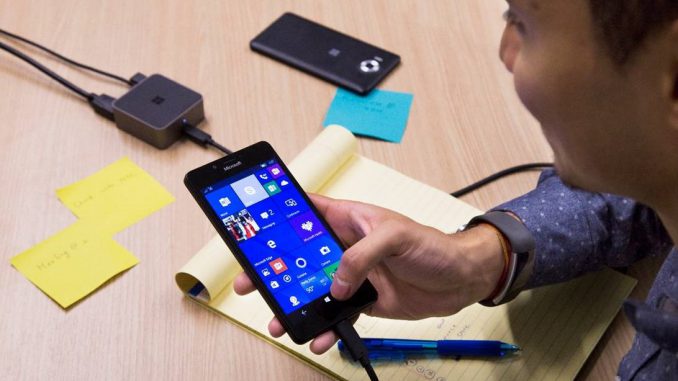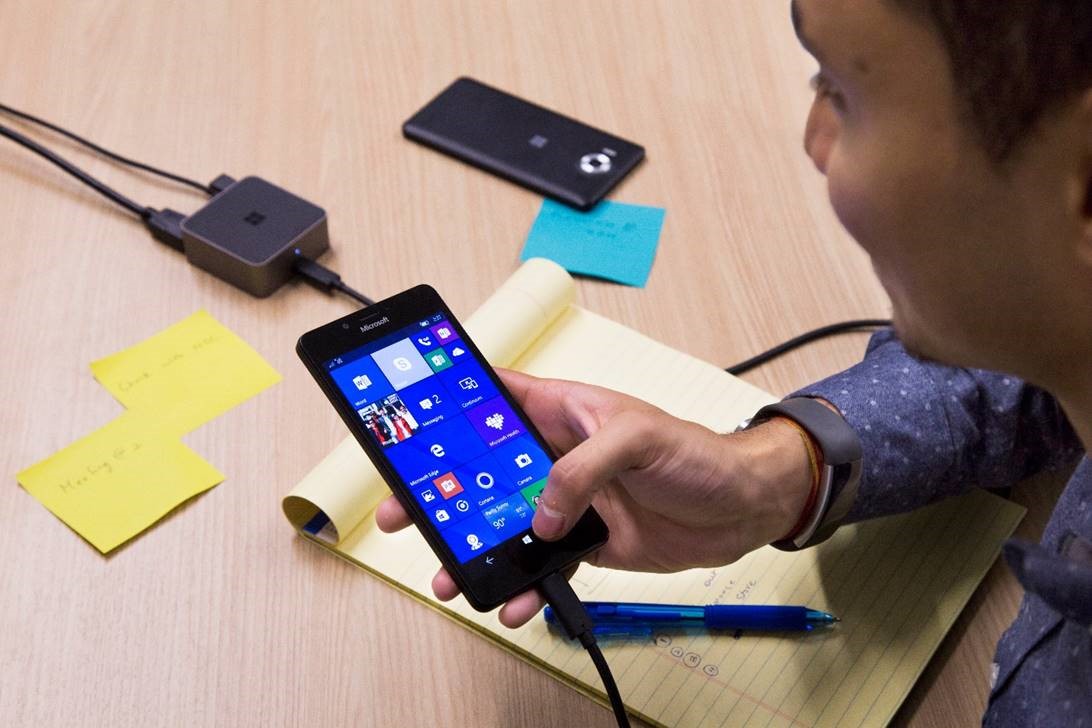
Microsoft Edge and Continuum: Your desktop browser on a phone

Continuum for Phones, available on select Windows 10 Mobile devices, allows customers to connect their phone to a monitor, projector, or TV for a full-sized desktop experience, powered by their phone. Because Microsoft Edge is built on the Universal Windows Platform, Microsoft Edge in Continuum is able to provide a full desktop browser experience.

Windows 10 phone connected to Lumia Display Dock for Continuum
Let’s walk through a quick overview of how Continuum works and a few key differences between Microsoft Edge running in Continuum and on a PC.
Using Continuum on Windows 10 Mobile
Continuum allows Windows 10 Mobile users to have a PC-like experience when connected to an external display and a mouse and keyboard. When connected (via a wired dock or via Bluetooth and Miracast), Universal Windows Apps like Office and Microsoft Edge will adapt their interface and behavior to provide a desktop-like experience tailored to mouse and keyboard input.
Check out the Continuum product page, FAQ, and Getting Started Guide to learn more about Continuum.
Microsoft Edge on Continuum
Microsoft Edge takes full advantage of the Universal Windows Platform to provide a complete desktop-like experience in Continuum — when the device is connected to a larger display, Microsoft Edge turns into a desktop browser, adapting the interface and rendering characteristics to match Microsoft Edge on PCs.
In fact, Microsoft Edge in Continuum is nearly indistinguishable from its PC twin, which is a fun party trick when presenting at events or in meetings!

Microsoft Edge running in Continuum
To enable an experience that’s as true to the desktop equivalent as possible, there are a couple of important things to keep in mind.
One rendering engine
Because Microsoft Edge uses the same engine across all Windows 10 devices, the rendering behavior is the same across Windows 10 devices, including Windows 10 Mobile devices. The only differences are due to certain device-specific qualities – for example, codec support may be different on phones due to missing hardware acceleration, and Flash is not supported on Windows 10 Mobile. Because Windows 10 Mobile has a different background model, RTC is also currently not supported. Finally, Windows 10 Mobile does not support Flash in order to provide a modern, touch-focused, and power-efficient experience appropriate for a mobile device. Because of this, Flash is not supported in Microsoft Edge in Continuum.
Details for web developers
Developers in general won’t have to give any special consideration to Microsoft Edge in Continuum. By design, it will behave like a desktop client, including sending a desktop User-Agent string.
As always, we recommend that you don’t try to detect based on the User Agent string — if you use responsive design and feature detection, your site should just work on Continuum. However, for some cases, including analytics or to provide a specifically tailored experience, developers may wish to detect when Microsoft Edge is running in Continuum.
In Continuum, Microsoft Edge changes a few tokens to make sure it gets desktop markup:
Microsoft Edge UA (Mobile)
Mozilla/5.0 (Windows Phone 10.0; Android 6.0.1; Microsoft; <Device>) AppleWebKit/<Rev (KHTML, like Gecko) Chrome/<Rev> Mobile Safari/<Rev> Edge/<Rev>
Microsoft Edge UA (Continuum)
Mozilla/5.0 (Windows NT 10.0; ARM) AppleWebKit/<Rev> (KHTML, like Gecko) Chrome/<Rev> Safari/<Rev> Edge/<Rev>
Microsoft Edge UA (Desktop)
Mozilla/5.0 (Windows NT 10.0; Win64; x64) AppleWebKit/<Rev> (KHTML, like Gecko) Chrome/<Rev> Safari/<Rev> Edge/<Rev>
The revision numbers will, as in all browsers, change regularly as Microsoft Edge is updated, to ensure modern markup is received.
Independent scroll
Running desktop sites on phone is challenging, so we’ve made optimizations in the Anniversary Update to tailor performance to provide a more desktop-like experience. On PCs, Microsoft Edge offloads scrolling from the UI thread to provide a more fluid scrolling experience during page load/painting. In the Anniversary Update, this same feature is now supported in Continuum, even when scrolling via the mouse or keyboard. This results in a smoother experience even while the page is loading or painting.
Switching from mobile to desktop
Microsoft Edge will recognize when a phone switches into Continuum and any sites opened after the switch will render using desktop behavior, including the desktop UA string.
If a tab is open to a mobile site, and the device switches to Continuum, the tab will be sustained. If the tab is refreshed, and it isn’t a mobile-specific URL, it will reload in a desktop view. This ensures that users do not lose unsaved changes (such as a partially-filled form) on a site while switching from the phone to Continuum.
We’re committed to making Continuum as close to the desktop experience as possible without adding any additional overhead for Web Developers – try it out on a Windows 10 Mobile device and let us know what you think! If you have questions or are curious how your site looks in Continuum, reach out to @MSEdgeDev on Twitter, and we’d be happy to help.
― Balaji Bhaskar, Program Manager, Microsoft Edge
Source: Microsoft Edge and Continuum: Your desktop browser on a phone






Leave a Reply